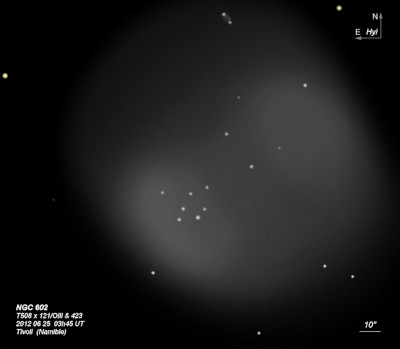
James Dunlop discovered NGC 602 = D 17 = h2421 on 1 Aug 1826 with his 9-inch f/12 speculum reflector and described "a faint round nebula, about 2' diameter, a very little brighter in the middle, with some minute stars in it." Dunlop's position is just 3' E of this SMC cluster.
On his first sweep on 11 Apr 1834, John Herschel logged "pB, S, irregularly round, psb but not to the middle, but rather to a point near the southern edge. Is decidedly resolved, and has scattered stars. (This is an outlier of the Nubecula Minor)". On a second sweep he called it "B, R or lE, psbM to a star; has also a star involved which looks like a second nucleus and several small stars about it." JH credited Dunlop with the discovery.
Joseph Turner observed this object on 26 Jan 1879 with the 48" Melbourne Telescope and noted there was clearly a double star in the center.
400/500mm - 18" (7/6/02 - Magellan Observatory, Australia): at 228x, a knot of stars is embedded in a 3' fairly bright oval nebula (Henize N90). On closer inspection the knot of stars is offset to the SE side of the nebula. At 171x and UHC filter, the nebulosity is fairly bright and clearly locally brighter on the SE end around the knot of stars. A weak dark rift, running SW-NE, separates the fainter portion of nebulosity to the NW. This nebulous cluster is an outlying member of the SMC.
600/800mm - 25" (10/17/17 - OzSky): at 244x; NGC 602 is a large nebulous cluster (SMC-N90) that was clearly brighter on the southeast end. The total size is ~3' with the southeast end fairly bright, fairly large, irregular shape. A tight knot of three stars is near the center. Additional stars are involved near the edges. A weak dust lane was on the west end oriented SW-NE, separating the roundish western section. A mag 13.8 star (O3-type Sk 183) is involved just west of the dust lane. This star is one of the massive O-type stars in the SMC and the dominant ionizing source of the nebula. The two portions are separated (barely) without a filter but tangent when I added a NPB filter. A mag 12.5 star is off the SW side (1.8' from center) and a mag 13 star is off the north side, 2.2' NNW of center. NGC 602, along with N89 and N88 to the northwest, are situated along the boundary of SMC-1 (also called SMC-SGS 1), the only supergiant shell in the SMC, with a diameter of ~1°..
SMC-N89, located 20' NW, is fairly faint, large, roundish, irregular glow, ~3.5' diameter. At the northeast end are four mag 11.5/12/12.5/13 stars (part of Hodge association 67) in a near equilateral triangle with a 4th star at the center and a 12th mag star is at the E or SE end of the nebulosity. Lindsay 104 is a very faint, unresolved patch (cluster) just southwest of the four distinctive stars. Situated at the western boundary of SMC-1.
SMC-N88, located 33' NW, is dominated by a Highly Ionized Blob (HEB) of only 3.5" diameter and mag ~12.5. At 244x + NPB filter it appeared as a bright "star" or quasi-stellar object surrounded by faint nebulosity on the east and south side. I assume there was a contrast gain with the filter as this dense, high-excitation object has a ratio of O III lines/H-beta > 10.5. The nebula is surrounded by Hodge Assoication 64 including a mag 14 star 2' E, two close mag 14 stars 1.8' SE and a mag 14.5 star 1' SSE. A mag 11.2 star (part of Hodge Associatin 65) lies 5.6' S. Situated at the NW edge of supershell SMC-1.
Notes by Steve Gottlieb